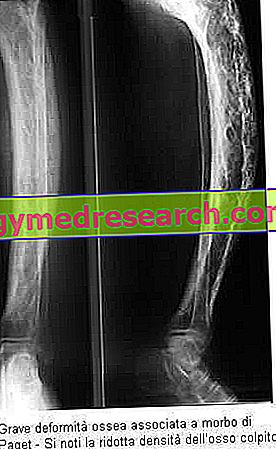Generality
Paget 's disease is a metabolic disease of the bone, also known as deforming osteitis or Paget's bone disease . The pathology involves an alteration of the bone remodeling, which occurs with an exaggerated and disordered rhythm, undermining the structural integrity of the skeleton and predisposing it to fractures and osee malformations.
Bone renewal (or remodeling) is a metabolic process of destruction and regrowth of the bone, aimed at its continuous renewal, thus maintaining its functional and structural integrity.

What is Paget's disease
Bone is a metabolically active tissue. The dynamic nature of bone structures is evident, not only during the age of growth, but also for the ability to adapt its structure in response to external forces and to repair itself after a fracture.
The restructuring of the bone is called remodeling and takes place thanks to the presence of two different types of cells, located on the outer surface and in the cavities of the bone structures. Osteoblasts ("bone producers") are responsible for building bone mass through a deposition process, while osteoclasts ("bone breakers") are responsible for the demolition of bone tissue through a process called resorption . When the activity of osteoblasts exceeds that of osteoclasts bone growth occurs, vice versa when osteoclasts prevail there is a reduction in bone mass.
In patients with Paget's bone disease, the normal process of bone turnover is disrupted. The dynamic balance present between osteoblasts and osteoclasts is indeed lacking: the demolition of the bone tissue takes place very quickly and is followed by an abnormal neoformation, where the bone structure is disorganized and deformed. Initially, there is a marked increase in bone resorption in localized areas, due to the activity of numerous osteoclasts. Osteolysis is followed by a compensatory increase in bone formation, induced by osteoblasts recruited in the area. The intense and accelerated osteoblastic activity produces a coarse tissue, formed by thick lamellae and trabeculae that are arranged in a chaotic manner ("mosaic" model), rather than respecting the normal lamellar model. The resorbed bone is replaced and the medullary spaces are filled with an excess of fibrous connective tissue, with a marked increase in new blood vessels (hypervascularization of the newly formed bone). Bone hypercellularity can therefore cause malignant degeneration (pagetic bone).
The pathological alteration of the bone resorption and neoformation cycle makes the new bone larger and softer, therefore fragile and prone to fractures. Paget's disease is typically localized and as such affects only one or a few bones, unlike, for example, osteoporosis (generalized bone disease). The disease most frequently affects the bones of the pelvis, skull, spine and legs. Possible complications depend on the affected bone segment and may include bone fractures, arthrosis, hearing loss and compression of nerve structures due to increased bone volume involved.
The risk of Paget's disease arising is related to increasing age: the disease is rarely diagnosed in people under the age of 40. Furthermore, some hereditary genetic factors seem to influence susceptibility to the disease and men are more affected than women (3: 2). Paget's bone disease occurs worldwide, but is more common in Europe, Australia and New Zealand. Worldwide, the United Kingdom has the highest prevalence.
Although there is no cure for Paget's disease, some medications can help control the disease and reduce pain and other symptoms. In particular, bisphosphonates, also used to strengthen weakened osteoporosis bones, are the mainstay of therapy. In severe cases, it may be necessary to resort to a surgical procedure. Currently, early diagnosis and drug therapy, especially if applied before complications arise, are measures that allow effective control of the disease.
Causes
The cause of Paget's bone disease is still unknown, although it is not excluded that the genesis of the disease may be multifactorial. Paget's disease can be sporadic or familial.
There are two currently accepted etiological hypotheses:
- Some genes seem to be linked to the disorder . Given the obvious familiarity in many affected subjects, the cause of Paget's disease could have to do with the expression of some genes, transmitted as an autosomal dominant trait. The genetic alterations that occur more frequently involve the expression of RANK (Receptor Activator of Nuclear Factor k B, which activates osteoclasts and initiates their differentiation) and the Sequestosome1 (SQSTM1) gene, which encodes the p62 protein involved together ubiquitin and other cytoplasmic proteins, in modulating the function of nuclear growth factor NFkB, important for the recruitment of pre-osteoclasts and activation of the osteoclasts themselves.
- Viral infection . A slow replication virus would localize at bone level many years before the onset of symptoms. This infecting agent could attack osteoclasts and induce a hyper-reactive response to activating factors, such as vitamin D and RANKL (ie the RANK receptor ligand). Even the pathologist James Paget, who first provided a precise description of the disease (hence the name), suggested that the disease was potentially due to an inflammatory process. Recent data support this etiological hypothesis and suggest that the cause of Paget's disease could be due to a paramyxovirus infection. However, no infectious virus has yet been isolated from the affected tissues and identified as a causative agent, so this hypothesis remains to be confirmed.
Symptoms
To learn more: Symptoms of Paget's Disease
Many patients do not know they are suffering from Paget's disease, since the disorder can occur in a subtle, asymptomatic or with mild symptoms. In many cases, the diagnosis is defined accidentally or only after the onset of complications. When symptoms occur, the most common disorder is bone pain. The disease can affect individual bones (for example: skull, tibia, ileus, femur, humerus and vertebrae) or be spread to multiple areas of the body. In some cases, skin temperature may increase in areas where the disease is active.
Common symptoms of Paget's disease may include:
- Bone pain and joint stiffness (pain can be severe and present most of the time);
- Numbness, tingling and weakness;
- Bone deformities: enlargement of the affected segments and other visible deformities, such as those affecting the skull (frontal bumps, enlarged jaw or increased head size).
Other less common signs will depend on the part of the body involved, including:
- Hearing loss and tinnitus (due to compression of the vestibulocochlear cranial nerve VIII).
- Dizziness and headache, due to excessive growth of the bones of the skull;
- Pain or numbness along the course of a nerve, if the vertebral column is affected and a spinal nerve root (radiculopathy) is crushed;
- Long bone inclination;
- Spinal stenosis (narrowing and compression of the spinal cord and nerves).
In most cases, Paget's bone disease progresses slowly and can be managed effectively in almost all people.
Paget's disease, especially if neglected, can induce other medical conditions, including:
- Complete bone fractures or cortical bone fissures. Pathological ruptures can produce copious blood loss due to the typical hypervascularization of pagetic bone.
- Osteoarthritis and secondary arthrosis: deformed bones can increase the amount of stress on the joints adjacent to the bone affected by the disease. For example, arthritis can be caused by the bending of the long bones of the legs, distorting their alignment and increasing the pressure on the neighboring joints (knee, hip and ankle). Furthermore, pagetic bone can increase its size, causing joint cartilage wear and knee or hip tearing. In these cases, the pain may be due to a combination of Paget's disease and osteoarthritis.
- Osteosarcoma (malignant tumor of the bone): the neoplastic transformation is a very rare occurrence, described in the most severe forms, which should be considered when pain arises or worsens suddenly and sensitively.
- Deafness in one or both ears can occur when Paget's bone disease affects the skull and the bone surrounding the inner ear. Treatment can slow down or stop the hearing loss and hearing aids can support this condition.
- Some cardiovascular diseases may result from a severe Paget's disease (with skeletal involvement greater than 15%). In bone, arteriovenous connections can often form, therefore, the heart must increase its workload (ie pump more blood) to ensure adequate oxygen supply to the tissues. This increase in cardiac output can lead to calcification of the aortic valve. The resulting aortic stenosis can cause ventricular hypertrophy and potentially lead to heart failure.
- Other neurological complications: nerve compression syndromes and cauda equina syndrome. Paralysis of the cranial nerves can occur if the affected site is the skull base, whereas if Paget's disease affects the spine, paraplegia with functional deficiency or motor paralysis may occur. Rarely, when the skull is involved, there may be an involvement of the oculomotor nerves, with consequent disturbances of the visual field.
Paget's disease is not related to osteoporosis: although Paget's bone disease and osteoporosis may occur in the same patient, they are different disorders. Despite their marked differences, different treatments for Paget's disease are also used effectively for the treatment of osteoporosis.
Diagnosis
The diagnosis of Paget's disease may result from the investigation of specific suspect clinical signs or may be completely random.
Bone disease can be diagnosed using one or more of the following investigations:
Radiographic investigations
The Rx exam is the first choice investigation for the diagnosis of Paget's disease. It allows to obtain the radiological survey of the skeletal segment affected by the disorder (areas of bone resorption, bone enlargement and deformity) and represents the most important diagnostic tool for identifying any complications. The radiographic survey can be total body, pelvic or lumbar spine, depending on the site of the disease. Radionuclide bone scintigraphy is useful for determining the extent and activity of the disease. The scintigraphic investigation is recommended only after confirming the diagnosis with the traditional radiological examination, since many pathologies characterized by bone remodeling can provide a positive outcome. Its specificity is poor, but it is more sensitive than radiology in assessing the skeletal extent of Paget's disease. Finally, the Computerized Axial Tomography (CAT) can be of support in the differential diagnosis (arthrosis, osteoporosis, osteomalacia and bone metastases), it is useful to integrate the information acquired with the X-ray examination and to monitor the course of the disease.
Histological analysis
Bone biopsy is a required investigation in rare cases, necessary especially if malignant evolution is suspected. The pagetic bone is histologically characterized by a "mosaic" appearance.
Blood and urine tests
In one patient, values above the alkaline phosphatase norm in combination with non-altered calcium, phosphate and aminotransferase parameters may be indicative of Paget's bone disease. The increase in measurable alkaline phosphatase in the blood indicates cellular activation for bone tissue synthesis and is the marker with the highest diagnostic sensitivity. Serum total alkaline phosphatase is therefore the first choice marker for the diagnosis and monitoring of Paget's disease. The increase in urinary hydroxyproline levels attests to bone decomposition (it is found in skeletal pathologies and in particular in osteoporosis) . Other markers of abnormal bone turnover, found in urine samples, may also be deoxypyridinoline and N-telopeptide (both elevated). The urinary excretion of the isomerized C-telopeptide fragments are, on the other hand, very sensitive indicators for monitoring the activity of the disease and allow to evaluate the efficacy of the treatment. The dosage of calcemia, phosphorus and parathyroid hormone is usually normal, but immobilization can lead to hypercalcaemia, with consequent alteration of these parameters as well.
Paget's disease - Care and treatment »



